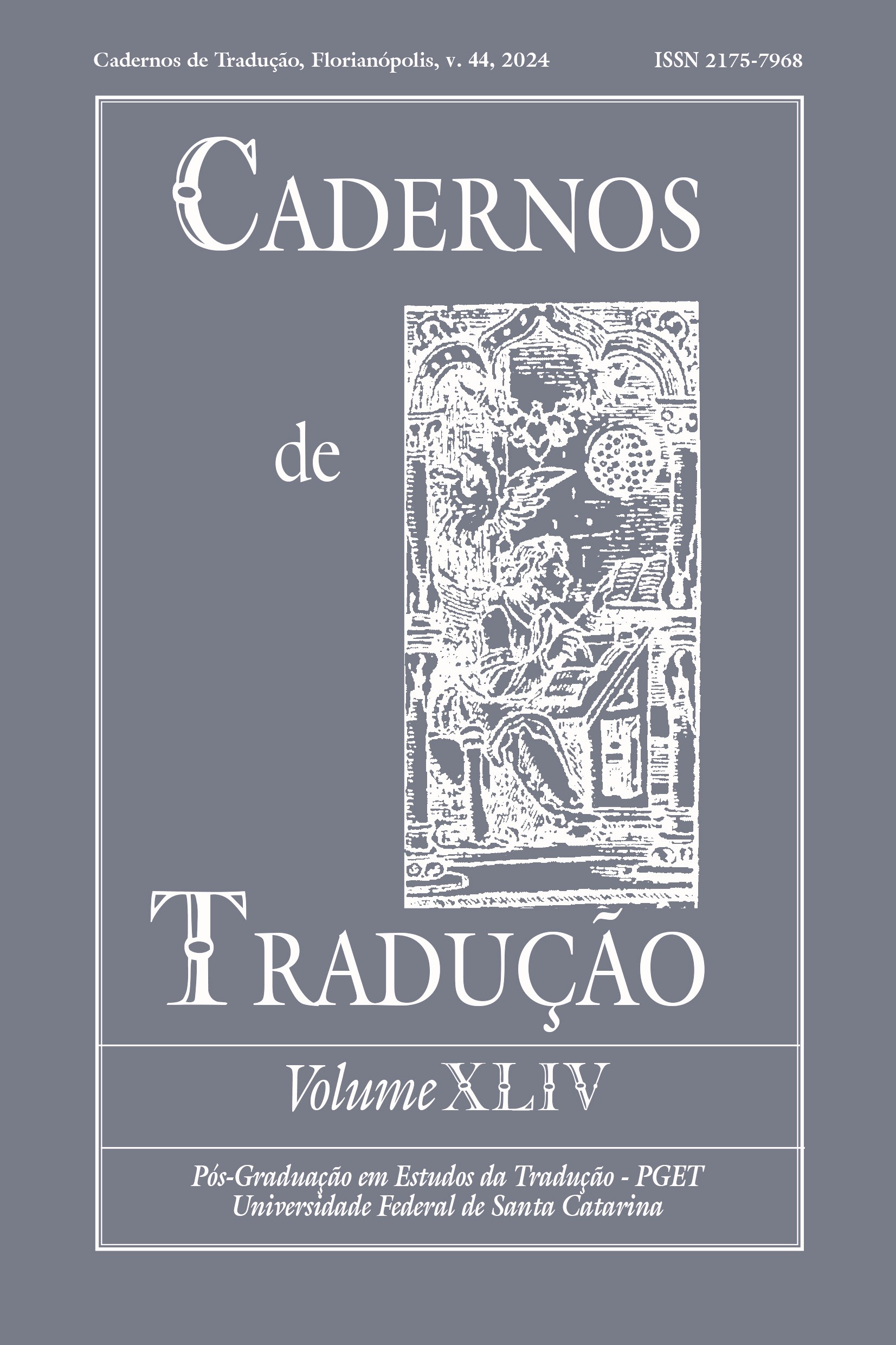Audiovisual translation, gender, and multilingualism: Godless or the return to a stereotyped feminist Western
DOI:
https://doi.org/10.5007/2175-7968.2024.e95236Palavras-chave:
Western, Godless, Audiovisual translation, Gender, MultilingualismResumo
The global phenomenon of multilingualism is increasingly common in film productions and television series, which often feature characters from different geographical and linguistic contexts. Until recently, women in such series were relegated to the background and their characters defined according to stereotyped gender roles. However, with gender roles beginning to shift at the turn of the millennium, it is worth studying if this change has steered the entertainment industry in a new direction. In this paper, we analyze the mini-series Godless (Frank, 2017), which at the time of release was advertised as a seven-episode feminist Western set in La Belle, New Mexico, a town populated mostly by widows after the collapse of the mine where the local men used to work. The premise of the series, which at first glance seemed to represent a clear departure from the stereotypes of the traditional American Western, is nonetheless not completely fulfilled. Although the female characters are featured prominently and show a clear development, they do not always break away from stereotypes, as the audience might expect. In this article we will analyze some of these female characters in order to determine whether they in fact portray a new style of woman or if, conversely, they perpetuate old clichés while disguising them as modernity. Moreover, questions pertaining to the depiction of multilingualism in the series are explored. Given that the linguistic hegemony of English in the series is challenged through the presence of two authentic third languages, namely Paiute and German, it is worth examining how this multilingual identity has been transferred in the Spanish version in order to confirm if it is maintained or lost and whether, overall, it perpetuates identity stereotypes.
Referências
Albertini. (15 July 2018). ‘Godless’, un deshilachado western que no saca partido a su interesante premisa. Spinoff.
Álvarez-Trigo, L. (2021). Mujeres en la pantalla: la bruja feminista en Chilling Adventures of Sabrina. Clepsydra, 20, 79−98. https://doi.org/10.25145/j.clepsydra.2021.20.04
Astre, G. A., & Hoarau, A. P. (1975). El universo del western (4th ed.). (M. Fernández Muro, Trad.). Editorial Fundamentos.
Averbach, M. (2000). Pistoleras, renegadas y modelos: Mujeres en el western de la década de los noventa. Debate Feminista, 21, 243−265.
Baldo, M. (2009). Subtitling Multilingual Films: The Case of Lives of the Saints, an Italian-Canadian TV Screenplay. In F. M. Federici (Ed.), Translating Regionalised Voices in Audiovisuals (pp. 117−135). Aracne.
Barker, C. (1999). Television, Globalization and Cultural Identities. Open University Press.
Barroso, M. (21 February 2021). 10 Reasons Why Godless Is the Best Netflix Original Series. High on Films.
Bleichenbacher, L. (2008). Multilingualism in the Movies: Hollywood Characters and Their Language Choices. Francke.
Cascajosa Virino, C. (2009). La nueva edad dorada de la televisión norteamericana. Secuencias: Revista de historia del cine, (29), 7−31.
Chaume, F. (2012). Audiovisual Translation: Dubbing. St. Jerome.
Chiaro, D. (2019). To Europe with Love: Woody Allen’s Liquid Society. In I. Ranzato & S. Zanotti (Eds.), Reassessing Dubbing: Historical Approaches and Current Trends (pp. 169−187). John Benjamins. https://doi.org/10.1075/btl.148.08chi
Chiaro, D., & De Bonis, G. (2020). Multilingualism and Translation on Screen. In Ł. Bogucki & M. Deckert (Eds.), The Palgrave Handbook of Audiovisual Translation and Media Accessibility (pp. 687−711). Palgrave Macmillan. https://doi.org/10.1007/978-3-030-42105-2_33
Clemente Fernández, M. D. (2007). Mujeres del Far West: Estereotipos femeninos en el cine del oeste. Área Abierta, (17), 5−15.
Corey, S. (2017). All Bi Myself: Analysing Television’s Presentation of Female Bisexuality. Journal of Bisexuality, 17(2), 190−205. https://doi.org/10.1080/15299716.2017.1305940
Corrius, M., & Zabalbeascoa, P. (2011). Language Variation in Source Texts and Their Translations: The Case of L3 in Film Translation. Target, 23(1), 113−130. https://doi.org/10.1075/target.23.1.07zab
De Higes-Andino, I., Prats-Rodríguez, A. M., Martínez-Sierra, J. J., & Chaume, F. (2013). Subtitling Language Diversity in Spanish Immigration Films. Meta: Translators’ Journal, 58(1), 134−145. https://doi.org/10.7202/1023813ar
De Higes-Andino, I. (2014). The Translation of Multilingual Films: Modes, Strategies, Constraints and Manipulation in the Spanish Translations of It’s a Free World… Linguistica Antverpiensia, New Series – Themes in Translation Studies, 13, 211−231. https://doi.org/10.52034/lanstts.v13i.47
Delabastita, D., & Grutman, R. (2021). Fictional Representations of Multilingualism and Translation. Linguistica Antverpiensia, New Series − Themes in Translation Studies, 4, 11−34. https://doi.org/10.52034/lanstts.v4i.124
Farley, R. (27 November 2017). Godless Makes an Excellent Point About Sex Work. Refinery29.
Fiske, J. (1987). Television Culture. Routledge.
Frank, S. (Creator). (2017). Godless. Netflix.
Freijo Escudero, L. A. (2018). A Gun of One’s Own: Gender Representation in Contemporary Western. [Doctoral Thesis]. University of Birmingham.
Galán Fajardo, E. (2007). Televisión Iberoamericana: Mujer, realidad social y ficción. Revista Latinoamericana de Comunicación Chasqui, (97), 44−49.
Gallego Ayala, J. (2021). Las mujeres ya no son lo que eran: Nuevos modelos femeninos en la narrativa audiovisual. Cuestiones de género: de la igualdad y la diferencia, (16), 323−347. https://doi.org/10.18002/cg.v0i16.6915
García Martínez, A. N. (2014). El fenómeno de la serialidad en la tercera edad de oro de la televisión. In E. Fuster (Coord.), La figura del padre nella serialità televisiva (pp. 19−42). Edizioni Santa Croce.
González-Iglesias, J. D., & Toda Iglesia, F. (2013). Traducción y conflicto: Perdidos en la traducción. In Á. Vidal Claramonte & M. R. Martín Ruano (Eds.), Traducción, política(s), conflicto: legados y retos para la era del multiculturalismo (pp. 27−43). Comares.
Grutman, R. (2020). Multilingualism. In M. Baker & G. Saldanha (Eds.), Routledge Encyclopedia of Translation Studies (3rd ed., pp. 341−346). Routledge.
Herman, A. (22 November 2017). ‘Godless’ Is a Beautiful but Unoriginal Western. The Ringer.
Hockenhull, S. (2020). 17. Women Gotta Gun? Iconography and Female Representation in Godless. In S. Matheson (Ed), Women in the Western (pp. 227−239). Edinburgh University Press. https://doi.org/10.1515/9781474444156-020
Holt, R. L. (2006). Beneath These Red Cliffs: An Ethnohistory of the Utah Paiutes. Utah State University Press.
Houghton, R. (24 November 2017). Netflix’s female-led series Godless still has 73% of dialogue delivered by men. Digital Spy.
Lauzen, M. M. (2020). Boxed In 2019-20: Women on Screen and Behind the Scenes in Television. Center for the Study of Women in Television and Film.
Lerma Sanchis, M. D. (2020). Algumas considerações sobre o multilinguismo na legendagem fílmica: um estudo de caso. Cadernos de Tradução, 40(Special Issue), 133−156. https://doi.org/10.5007/2175-7968.2020v40nespp133
Martín Varela, M. (2021). Apuntes para pensar la cuarta ola feminista y la Tercera Edad de Oro de las series de televisión desde los estudios de comunicación y género y los estudios culturales. Cuestiones de género: de la igualdad y la diferencia, (16), 348−368. https://doi.org/10.18002/cg.v0i16.6925
Matheson, S. (Ed.). (2020). Women in the Western. Edinburgh University Press.
Nevins, J. (22 November 2017). Godless review – Netflix's wonderfully wicked western fires on all cylinders. The Guardian.
Orús, A. (2023). Número de suscriptores de los principales servicios de streaming de vídeo a nivel mundial en 2022. Statista.
Pérez L. de Heredia, M. (2015). Traducción y globalización de estereotipos de género en televisión: una imagen panorámica. In M. A. Penas Ibáñez (Ed.), La traducción: nuevos planteamientos teórico-metodológicos (pp. 261−282). Editorial Síntesis.
Pérez L. de Heredia, M. (2016). Reescritura divergente y traducción de estereotipos de género en televisión: el caso de Orange is the New Black. In M. R. Martín Ruano & Á. Vidal Claramonte (Eds.), Traducción, medios de comunicación, opinión pública (pp. 193−208). Comares.
Pérez L. de Heredia, M., & Higes Andino, I. de. (2019). Multilingualism and Identities: New Portrayals, New Challenges. MonTI. Monographs in Translation and Interpreting, Special Issue 4, 9–31. https://doi.org/10.6035/MonTI.2019.ne4.1
Savoldelli, S., & Spiteri Miggiani, G. (2023). The Rendering of Multilingual Occurrences in Netflix’s Italian Dub Streams: Evolving Trends and Norms on Streaming Platforms. Languages, 8(2), 113. https://doi.org/10.3390/languages8020113
Schippers, M. (2007). Recovering the Feminine Other: Masculinity, Femininity and Gender Hegemony. Theory and Society, 36, 85−102. https://doi.org/10.1007/s11186-007-9022-4
Taylor, C. (2016). The Multimodal Approach in Audiovisual Translation. Target, 28(2), 222−236. https://doi.org/10.1075/target.28.2.04tay
Van Hecke, A., & Lanslots, I. (2020). Multilingualism and Cultural Transfer. Cadernos de Tradução, 40(Special Issue), 6−14. https://doi.org/10.5007/2175-7968.2020v40nespp6
Downloads
Publicado
Como Citar
Edição
Seção
Licença
Copyright (c) 2024 Cadernos de Tradução

Este trabalho está licenciado sob uma licença Creative Commons Attribution 4.0 International License.
Autores têm autorização para assumir contratos adicionais separadamente, para distribuição não exclusiva da versão do trabalho publicada nesta revista (ex.: publicar em repositório institucional ou como capítulo de livro, com reconhecimento de autoria e publicação inicial nesta revista).





















































